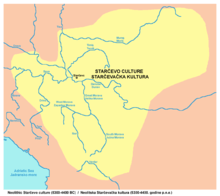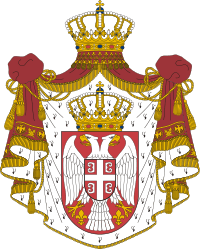Starčevo culture
The Starčevo culture, sometimes included within a larger grouping known as the Starčevo–Körös–Criş culture,[1] is an archaeological culture of Southeastern Europe, dating to the Neolithic period between c. 6200 and 4500 BCE.[2][3]
 | |
| Period | Neolithic Europe |
|---|---|
| Dates | circa 6,200 B.C.E. — circa 4,500 B.C.E. |
| Type site | Starčevo |
| Preceded by | Iron Gates culture, Mesolithic Romania, Körös culture, Sesklo culture, Dimini culture, Neolithic Greece |
| Followed by | Vinča culture, Gumelnița–Karanovo culture, Kakanj culture |
Part of a series on the |
||||||||||||||||
|---|---|---|---|---|---|---|---|---|---|---|---|---|---|---|---|---|
| History of Serbia | ||||||||||||||||
 | ||||||||||||||||
|
||||||||||||||||
|
||||||||||||||||
|
||||||||||||||||
|
||||||||||||||||
|
||||||||||||||||
|
| ||||||||||||||||
The village of Starčevo, the type site, is located on the north bank of the Danube in Serbia (Vojvodina province), opposite Belgrade. It represents the earliest settled farming society in the area, although hunting and gathering still provided a significant portion of the inhabitants' diet.
Characteristics and related cultures
The pottery is usually coarse but finer fluted and painted vessels later emerged. A type of bone spatula, perhaps for scooping flour, is a distinctive artifact. The Körös is a similar culture in Hungary named after the River Körös with a closely related culture which also used footed vessels but fewer painted ones. Both have given their names to the wider culture of the region in that period.
Parallel and closely related cultures also include the Karanovo culture in Bulgaria, Criş in Romania and the pre-Sesklo in Greece.
Localities
The Starčevo culture covered sizable area that included most of present-day Serbia and Montenegro, as well as parts of Bosnia and Herzegovina, Bulgaria, Croatia, Hungary, North Macedonia and Romania.[4][5]
The westernmost locality of this culture can be found in Croatia, in the vicinity of Ždralovi, a part of the town of Bjelovar. This was the final stage of the culture.[6][7][8] Findings from Ždralovi belong to a regional subtype of the final variant in the long process of development of that Neolithic culture. It is designated as Ždralovi facies of the Starčevo culture or the Starčevo - Final stages.
In 1990, Starčevo was added to the Archaeological Sites of Exceptional Importance list, protected by Republic of Serbia.
Origins
There are different opinions about the ethno-linguistic origin of the people of Starčevo culture. According to one opinion, Neolithic cultures of the Balkans were of non-Indo-European origin[9] and Indo-European peoples (originating from eastern Europe) did not settle in this area before the Eneolithic period. According to other opinions, Neolithic cultures of the Balkans were also Indo-European[10] and originated from Anatolia, which some researchers identified with a place of origin of Indo-European peoples.[10] These differing theories are termed the Kurgan hypothesis and the Anatolian hypothesis (see also; Proto-Indo-European Urheimat hypotheses).
Genetics
In a 2017 genetic study published in Nature, the remains of five males ascribed to the Starčevo culture was analyzed. With regards to Y-DNA extracted, three belonged to subclades of G2a2, and two belonged to H2. mtDNA extracted were subclades of T, K, N, W and X.[11][12]
See also
- Starčevo–Kőrös–Criș culture
- Körös culture
- Criş culture
- Archaeological Sites of Exceptional Importance
- Prehistoric Serbia
- Vinča culture
References
- Trbuhović 2006, p. 62.
- Istorijski atlas, Intersistem Kartografija, Beograd, 2010, page 11.
- Chapman, John (2000). Fragmentation in Archaeology: People, Places, and Broken Objects. London: Routledge. p. 237. ISBN 978-0-415-15803-9..
- Istorijski atlas, Intersistem Kartografija, Beograd, 2010, page 11.
- "The Starčevo culture". Retrieved 2017-12-05.
- Jakovljević, G. Arheološka topografija Bilogore, Bjelovarski zbornik ‘89, Bjelovar, 1989, pp 108-119
- Dimitrijević, S. Das Neolithikum in Syrmien, Slawonien und Nordwestkroatien - Einführung in den Stander Forschung, Archeologica Iugoslavica X, Belgrade, 1969, p 39-76 (45, 47)
- Dimitrijević, S. Sjeverna zona - Neolitik u centralnom i zapadnom dijelu sjeverne Jugoslavije, Praistorija jugoslavenskih zemalja II, Sarajevo, 1979, pp 229-360 (252-253)
- Mallory 2006, p. 312.
- Mallory 2006, p. 352.
- Lipson 2017.
- Narasimhan 2019.
Sources
- Books
- Trbuhović, V. (2006). Indoevropljani [Indo-Europeans]. Belgrade: Pešić i sinovi.
- Trifunović, Lazar, ed. (1968). Неолит Централног Балкана [Les regions centrales des Balkans a l'epoque neolithique]. Belgrade: Narodni muzej Beograd.
- Stalio, B.; Vukmanović, M. (1977). Neolit na tlu Srbije. Narodni muzej.
- Nenad N. Tasić (2009). Neolitska kvadratura kruga. Zavod za Udžbenike. ISBN 978-86-17-16535-0.
- Mallory, James P. (2006) [1991]. Indoeuropljani: zagonetka njihova podrijetla: jezik, arheologija, mit [In Search of the Indo-Europeans: Language, Archaeology and Myth] (Translated ed.). Školska knjiga. ISBN 978-953-0-61568-7.CS1 maint: ref=harv (link)
- D. Arandjelović-Garašanin, Starčevačka kultura (Ljubljana 1954).
- Journals
- Lipson, Mark (November 16, 2017). "Parallel palaeogenomic transects reveal complex genetic history of early European farmers". Nature. Nature Research. 551 (7680): 368–372. doi:10.1038/nature24476. PMC 5973800. PMID 29144465.CS1 maint: ref=harv (link)
- Mikić, Živko (1989). "Прилог антрополошком упознавању неолита у Србији". Гласник Српског археолошког друштва. Belgrade. 5: 18–26.
- Narasimhan, Vagheesh M. (September 6, 2019). "The formation of human populations in South and Central Asia". Science. American Association for the Advancement of Science. 365 (6457): eaat7487. bioRxiv 10.1101/292581. doi:10.1126/science.aat7487. PMC 6822619. PMID 31488661.CS1 maint: ref=harv (link)
- Тасић, Н., 1998. Старчевачка култура. Во Тасиђ Н.(уред.) Археолошко благо Косова и Метохије, Од неолита до раног средљег века. Музеј у Приштини. Београд: Српска Академија Наука и Уметности, pp. 30–55.
- Manson, J.L., 1992. A reanalysis of Starcevo culture ceramics: Implications for neolithic development in the Balkans.
- Kalicz, N., Virág, Z.M. and Biró, K.T., 1998. The northern periphery of the Early Neolithic Starčevo culture in south-western Hungary: a case study of an excavation at Lake Balaton.
- Minichreiter, K., 2001. The architecture of Early and Middle Neolithic settlements of the Starčevo culture in Northern Croatia. Documenta Praehistorica, 28, pp. 199–214.
- Clason, A.T., 2016. Padina and Starčevo: game, fish and cattle. Palaeohistoria, 22, pp. 141–173.
- Bartosiewicz, L., 2005. Plain talk: animals, environment and culture in the Neolithic of the Carpathian Basin and adjacent areas. Un) settling the Neolithic. Oxbow, Oxford, pp. 51–63.
- Barker, G., 1975, December. Early Neolithic land use in Yugoslavia. In Proceedings of the Prehistoric Society (Vol. 41, pp. 85–104). Cambridge University Press.
- Regenye, J., 2007. A Starcevo-kultúra települése a Tihanyi-félszigeten (A settlement of the Starcevo culture on the Tihany peninsula). Osrégészeti Levelek. Prehistoric Newsletter, pp. 8–9.
- Tasic, N., 2000. Salt use in the Early and Middle Neolithic of the Balkan Peninsula. BAR International Series, 854, pp. 35–40.
- Bogucki, P., 1996. The spread of early farming in Europe. American Scientist, 84(3), pp. 242–253.
- Bánffy, E., 2004. Advances in the research of the Neolithic transition in the Carpathian Basin. LBK dialogues: studies in the formation of the Linear Pottery Culture. British Archaeological Reports. Oxford: Archaeopress. p, pp. 49–70.
- Leković, V., 1990. The vinčanization of Starčevo culture. In Vinča and its world, International symposium–The Danubian region from (Vol. 6000, pp. 67–74).
- Boric, D., 1996. Social dimensions of mortuary practices in the Neolithic: a case study. Starinar, (47), pp. 67–83.
- Vitezović, S., 2012. The white beauty-Starčevo culture jewellery. Documenta Praehistorica, 39, p. 215.
- Regenye, J.U.D.I.T., 2010. What about the other side: Starčevo and LBK settlements north of Lake Balaton. Neolithization of the Carpathian basin: northernmost distribution of the Starčevo/Körös culture (Kraków/Budapest 2010), pp. 53–64.
- Brukner, B., 2006. A Contribution to the Study of Establishment of Ethnic and Cultural (Dis) continuity at the Transition from the Starčevo to the Vinča culture group. From Starčevo to Vinča culture, Current problems of the Transition Period, Proceedings from the International round table, Zrenjanin 1996, pp. 165–178.
- Vitezović, S., 2014. Antlers as raw material in the Starčevo culture. Archaeotechnology: Studying Technology from Prehistory to the Middle Ages, Srpsko arheološko društvo, Beograd, pp. 151–176.
- Nikolić, D., 2005. The development of pottery in the Middle Neolithic and chronological systems of the Starčevo culture. Glasnik Srpskog arheološkog društva, 21, pp. 45–70.
- Marinković, S., 2006. Starčevo Culture in Banat. Current Problems of the Transition Period from the Starčevo to the Vinča Culture. National Museum Zrenjanin, 1, pp. 63–79.
- Minichreiter, K., 2010. Above-ground Structures in the Settlements of the Starčevo Culture. Prilozi Instituta za arheologiju u Zagrebu, 26(1).
- St. Dimitrijević, Problem stupnjevanja Starčevačke kulture s posebnim obzirom na doprinos južnopanonskih nalazišta rješavanju ovog problema. In: N. Tasić (red.), Počeci ranih zemljoradničkih kultureu Vojvodini i Srpskom podunavlju. Materiali X, Subotica 1972 (Beograd 1974) 59-122.
- M. Garašanin, Centralnobalkanska zona. In: Praistorija jugoslavenskih zemalja II: Neolitsko doba (Sarajevo 1979) 79-212.
Further reading
- Shennan, Stephen (2018). The First Farmers of Europe: An Evolutionary Perspective. Cambridge World Archaeology. Cambridge University Press. doi:10.1017/9781108386029. ISBN 9781108422925.CS1 maint: ref=harv (link)
